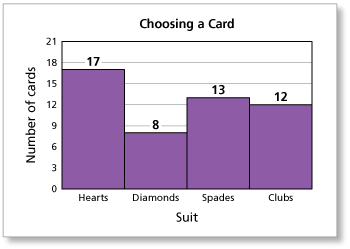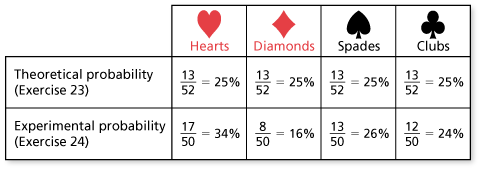-
You randomly choose a card from a standard deck of playing cards. Find the theoretical probability of choosing a card of each suit.

-
There are 52 cards in the deck and 13 of each suit. So, the probability of drawing any particular suit is

Comments (0)These comments are not screened before publication. Constructive debate about the information on this page is welcome, but personal attacks are not. Please do not post comments that are commercial in nature or that violate copyright. Comments that we regard as obscene, defamatory, or intended to incite violence will be removed. If you find a comment offensive, you may flag it.
When posting a comment, you agree to our Terms of Use.Showing 0 commentsSubscribe by email Subscribe by RSSThere are no comments. -
-
You have a standard deck of cards. The bar graph shows the results of randomly choosing 1 card, recording its suit, and placing it back in the deck for 50 trials. Find the experimental probability of choosing a card of each suit.

These comments are not screened before publication. Constructive debate about the information on this page is welcome, but personal attacks are not. Please do not post comments that are commercial in nature or that violate copyright. Comments that we regard as obscene, defamatory, or intended to incite violence will be removed. If you find a comment offensive, you may flag it.
When posting a comment, you agree to our Terms of Use. -
Compare the probabilities found in Exercises 23 and 24.
-
The theoretical and experimental probabilities for drawing each suit are as follows.

Anyone who has played cards recognizes that a theoretical probability is the result you expect over hundreds or even thousands of card hands. For a small number of hands (like 50), the results can vary. This is the whole point of card games, isn't it? You are hoping that you will have good "luck" and that your "experimental probability" will be better than the average.
These comments are not screened before publication. Constructive debate about the information on this page is welcome, but personal attacks are not. Please do not post comments that are commercial in nature or that violate copyright. Comments that we regard as obscene, defamatory, or intended to incite violence will be removed. If you find a comment offensive, you may flag it.
When posting a comment, you agree to our Terms of Use. -
-
The probability that one of two events occurs is

You randomly choose a card from a standard deck of cards. Find the probability of choosing a heart or a 6.

These comments are not screened before publication. Constructive debate about the information on this page is welcome, but personal attacks are not. Please do not post comments that are commercial in nature or that violate copyright. Comments that we regard as obscene, defamatory, or intended to incite violence will be removed. If you find a comment offensive, you may flag it.
When posting a comment, you agree to our Terms of Use. -
The probability that one of two events occurs is

You randomly choose a card from a standard deck of cards. Find the probability that the card is black or a 2.

-
Here are the individual probabilities.

So the probability of drawing a black card or a 2 is about

These comments are not screened before publication. Constructive debate about the information on this page is welcome, but personal attacks are not. Please do not post comments that are commercial in nature or that violate copyright. Comments that we regard as obscene, defamatory, or intended to incite violence will be removed. If you find a comment offensive, you may flag it.
When posting a comment, you agree to our Terms of Use. -
-
The probability that one of two events occurs is

You randomly choose a card from a standard deck of cards. Find the probability of choosing a face card or a diamond.

These comments are not screened before publication. Constructive debate about the information on this page is welcome, but personal attacks are not. Please do not post comments that are commercial in nature or that violate copyright. Comments that we regard as obscene, defamatory, or intended to incite violence will be removed. If you find a comment offensive, you may flag it.
When posting a comment, you agree to our Terms of Use.





